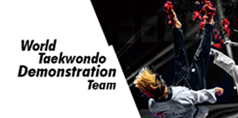
MOSCOW, Russia (20 June, 2014) - In the universe of martial arts and combat sports – from boxing to judo, from wrestling to capoeira, from fencing to kendo – one system stands out for its heavy kick quotient: taekwondo.
Although the sport's Korean name translates to "the way of foot and fist," it has always focused most heavily on leg techniques. While taekwondo cannot compete with boxing in terms of punching or fencing in terms of sword-fighting, when it comes to the high kick, taekwondo reigns supreme.
This emphasis is what drew Japanese para-athlete Hiroki Sugita, 28, to taekwondo after a devastating accident.
"When I was 20 years old, I had a car accident: I was sitting next to the driver, a friend of mine," he recalls. The car crashed, leaving him with a serious disability.
Japan boasts a wealth of domestic martial arts and combat sports, such as judo, karate and kendo. But judo requires a strong hand grip and kendo needs two hands to hold the bamboo sword. For a young man with Sugita's disability, a striking style was most appropriate. The choice came down to karate or its close cousin, taekwondo.
"Karate is more forceful, taekwondo is more agile," he said. "And my left arm is very problematic, so I wanted to find a sport that uses only the legs."
In the run-up to the 5th World Para-taekwondo Championships in Moscow, Sugita has been doing physical and tactical training, but his core workouts have focused on taekwondo's signature footwork. "My main training has been stretching and the basic kicks," he explained.
Given the disabilities affecting most of its contestants, this weekend's championships will permit punches to the body, but will not award points for them, further strengthening para-taekwondo's kick-centricity.
This emphasis is in line with para-taekwondo's current stage of development and the para-athletes it attracts, said a senior official with the sport's world governing body.
"It is important that we broaden our base, we have to be inclusive," said Jacobus Engelbrecht, who heads the World Taekwondo Federation's Para-Taekwondo Committee. "It is about making sure opportunities are created."
But, Engelbrecht continued, it is also important to focus on the sport's core strengths in the here and now. "Let us develop one area properly," he said. "At the moment, in the 5th World Para-TKD Championships, it is mainly for upper body amputees and limb deficiencies."
In other words: Taekwondo's famed kicks are, right now, being as heavily emphasized in the para-sport as they are in the regular sport.
This, however, is not to say that taekwondo is simply about fast and forceful kicking; like all sports, it is equally about fair and friendly competition.
To return to Sugita: As the lone Japanese competitor in the tourney, he hopes to win more than medals.
"In Japan, there are not that many para-sparring athletes, though there are quite some poomsae athletes," he said; poomsae - the practice of solo form routines – is taekwondo's artistic rather than its martial side. "I want to exchange and meet and make friends at this championship. I want more interactions."


































